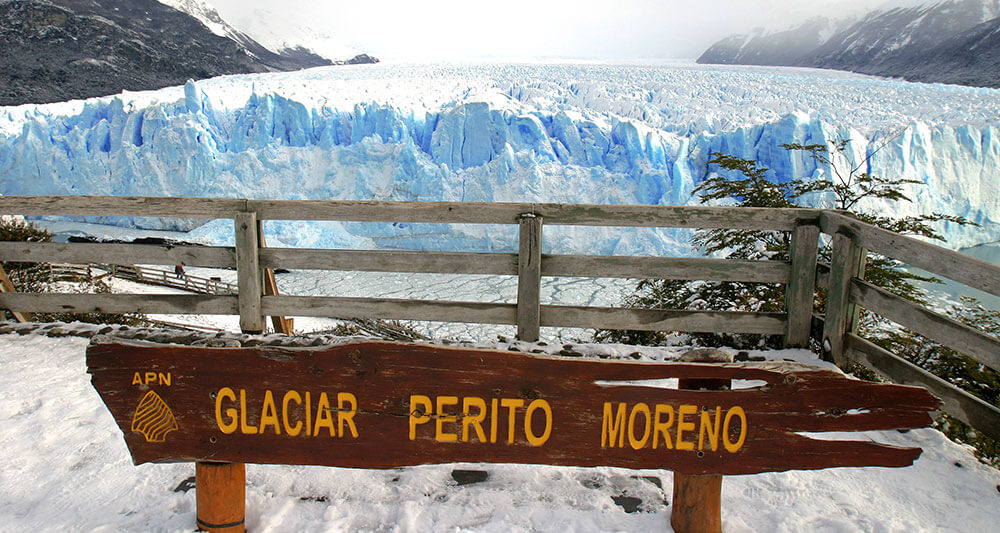
Glaciers in South America
When people think of South America, they often conjure visions of eternal summer— warm sandy beaches, glistening waves, tropical jungles and beautiful people. But, in a highly diverse geographic region boasting everything from high Andean peaks and vast grasslands to expansive deserts and fertile valleys, it’s possible to experience a wide array of topography, wildlife and cultures in relatively small areas.
One awe-inspiring feature many travelers overlook in South America are its larger than life glacial fields. Some of the most amazing on the planet, the South American glacial fields include mountain glaciers surrounded by snowcapped peaks, valley glaciers and ice fields that spill down into valleys, tidewater glaciers and icebergs, piedmont glaciers on seemingly endless plains, hanging glaciers left from large retreating valley glaciers, bowl-like cirque glaciers, mountainous ice aprons, sloping rock glaciers, marine ice shelves, ribbon-like ice streams, ice fields and ice caps.
Break out the snow boots, parka and Patagonia fleece because you’re going to need them in this chilly winter climate.
Many, though not all, of South America’s glaciers are found in Chile and Argentina’s Patagonia regions. Others are dotted throughout Colombia, Peru, Ecuador and Bolivia. Visiting these areas to see their disappearing natural wonders is one of our can’t miss experiences in Latin America and one of our founder’s most favorite ways to spend a South America vacation.
Here are some of the glaciers that make our Must See list in South America:
Perito Moreno Glacier | Argentina
One of the world’s only advancing glaciers and one of the most popular tourist destinations in Argentina, Perito Moreno Glacier is located in Patagonia’s Los Glaciares National Park. This important national park and its ecological wonders, including abundant glaciers, are fed by the Southern Patagonian Ice Field on the Andean border with Chile. This formidable ice field is the planet’s third largest fresh water reserve, so it should come as no surprise that Perito Moreno is a behemoth at three miles wide, a total ice depth of more than 500 feet and average heights of 250 feet. No list of South America’s best glaciers is complete without it, and if you’re lucky enough to catch a rare rupture, we promise you’ll never forget it.
Upsala Glacier | Argentina
Also in Patagonia’s Los Glaciares National Park, Upsala is a huge valley glacier flowing from the Southern Patagonian ice field and feeding into Perito Moreno Glacier. Unlike Perito Moreno (and most other glaciers in the world), Upsala is retreating and is widely known for its relatively rapid retreat in recent years. It is one of the largest glaciers (next to Perito Moreno) in all of South America, spanning more than six miles along the northern shore of Lake Argentina (Lago Argentino) with a length of some 30 miles and an ice depth of several hundred feet. Getting here is half the fun and likely will include a bit of trekking, boating and 4×4 driving. There also is horseback riding in the area.
Glacier Lagoon | Bolivia
Another quickly receding glacier on our list also is located near one of the highest lakes in the world— Lake Titicaca on the Bolivia-Peru border. Laguna Glacier, on the Bolivia side, is a stunning geological spectacle located in the Andean Cordillera Real. Here, nestled between the Janq’u Uma and the peak of Illampu is a frosty blue glacially-fed lake with icy glacial peaks as the backdrop. From this magical locale, it is possible to view both the Amazonian jungle and the stunning Lake Titicaca. The glacier for which the lagoon is named has receded nearly 200 feet in only the last few years, so you don’t want to miss your chance to see it before it disappears altogether. Be prepared that, at more than 16,000 feet, this is a high altitude excursion that should be treated with respect.
Serrano and Balmaceda Glaciers | Chile
Chile’s Serrano and Balmaceda Glaciers, inside Bernardo O’Higgins National Park outside Puerto Natales in Andean Chilean Patagonia, present a twofer situation in terms of glacier tours. A roughly seven-hour boat trip takes visitors through the Strait of Magellan, alongside colonies of sea lions and cormorants, before arriving at the Balmaceda Glacier. Virtually untouched by humans, this majestic glacier boasts a nearly 7,000-foot extension featuring periodic ice breaks that are bound to take your breath away. About a 20-minute walk from Balmaceda, visitors will find the Serrano Glacier— in an even more remote and rarely visited area of Chile’s vast and least visited national park. Another glacier within easy distance of this dynamic duo is Tyndall Glacier.
Grey Glacier | Chile
Bordering Chile’s Bernardo O’Higgins National Park and Argentina’s Los Glaciares National Park, Torres del Paine National Park is, perhaps, the most visited of all the national parks in Patagonia. With it’s sweeping Patagonian vistas of the Southern Patagonia Ice Field, rolling plains, vibrantly colored lakes and so much more, there are four main glaciers here— Tyndall, Zapata, Dickson and Grey. Although they’re all beautiful, Grey looms nearly 100 feet tall and a half mile wide and flows into Grey Lake. For the intrepid trekker, we recommend the roughly two-hour hike from Grey out to the French Valley. Here, visitors will find intriguing hanging glaciers flanked by the tall granite cliffs of Cordillera del Paine that play sentinel to abundant evergreens, rushing glacial fed rivers and untamed native wildlife. This is the very essence of Torres del Paine National Park.
Ritacuba Blanco | Colombia
Another alpine-esque Andean summit, Ritacuba Blanco is Colombia’s tallest accessible peak. It is located in the Cordillera Oriental and, while the trek is a relatively easy one, the weather can be tricky in this region. Still, we recommend making the trip to see a retreating glacier on the hiking route that, like most of the country’s snowcapped peaks, could be completely gone as soon as 2025. It wasn’t that long ago, only a little more than a decade, that this area was completely inaccessible to international travelers. Formerly a hotbed of guerrilla activity, today Cocuy National Park safely attracts a global audience to its natural siren’s song. Most of this trip is a leisurely nature walk, but the glacier at the top 1,000 feet includes some potentially dangerous crevasses and, like all our other favorite glacier trips, we highly recommend a professional guide and appropriate equipment.
Antisana | Ecuador
Also located within the Andean Cordillera Oriental, Ecuador’s Antisana is the fourth tallest volcano in the country and is widely considered to be one of the most difficult technical climbs in the region. At more than 18,000 feet, the equatorial peak once was completely covered by the biggest expanse of ice in Ecuador but, like most glaciers, now is disappearing with nearly half lost since 2000. In addition to this rapid retreat, scientists also estimate Antisana’s ice caps are thinning by up to 35 inches each year. Still, Antisana is believed to be among the very best examples of continental tropical glaciation and definitely worth a visit for those willing to make the trek. Instead of large ice fields like those in Patagonia, expect to see ice caps that spill down mountain summits and into chilly streams watering the vast plains below. Once you reach the top and look out at the landscape, you may just feel like you can touch the sky!
Cordillera Blanca | Peru
If you’re keen to blend a cultural journey with your visit to one of South America’s glaciers, a trip to the Qolqepunku Glacier in Peru’s Cordillera Blanca will be right up your alley. A sacred Inca site in the high Andes but only about 50 miles from Cusco, Qolqepunku Glacier is home to an annual pilgrimage that pays homage to the mountain spirits. Each May or June, more than 100,000 pilgrims make the journey in sub-zero temperatures for Qoyllur Rit’i— they even camp there! Unfortunately this sacred site, like so many other of the continents glaciers, is quickly disappearing and could be completely gone inside 40 years. In fact, Peru has lost at least 30 percent of its glaciers since just before the turn of the century. In keeping with this rapid loss, the pilgrims have ceased the previous custom of carrying glacial ice home with them to water their crops and bring a bountiful harvest.
Visiting South America’s impressive glaciers is truly one of the continent’s most humbling experiences. If you’re to strap on those ice cramps, don your snow suit and hit the road to one (or several) of our favorite glaciers, contact us today to begin planning your dream journey.





















